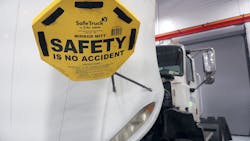Can you see that tiny dot? Look closer. Let me tell you about that dot, and why doing things the right way when working on vehicles and always following proper safety procedures matters, every time and even if it feels like no big deal.
Just last night I had to check something out on my car. I'd been hearing this rattle underneath, so I thought I'd take a quick look to see if it was something obvious.
I pulled the car up on ramps in the driveway and chocked the wheels. It's getting dark pretty early now, and light was fading. Grabbed a flashlight to help but I could still see fine; got some gloves, tools, and one of my million pairs of safety glasses over by the workbench.
Engine running, there was the rattle. I slid underneath. Seemed to be coming from a buzzing heat shield, so I pressed at them with a ratchet to see—wasn't that one over the exhaust pipe, not the one over the catalytic.
I unbolted part of that latter shield so I could reach the lower end of another above the exhaust manifold. Bingo, there was the rattle. Engine off, I removed some parts above so I could get at it. A loose bolt was causing the heat shield to vibrate.
Bolt tightened and rattle gone, so was the sunlight, and garage lights and flashlight it was. Should've grabbed a trouble light, but I put the car back together and put away the tools.
Except... what's that bolt laying there? Oh, right—forgot to put that back into the heat shield over the catalytic.
No problem. I slid back under to take care of it, leaving behind the gloves and safety glasses I'd taken off and put in the garage.
I don't know why or how it is that anything that falls off of engines seems to aim straight for your eyes, but it does. I barely noticed, but something hit my left eye as I tightened the bolt back in.
I blinked a bunch of times hoping to clear it, pulled the car off the ramps, and went for a spin to test it out. All good.
But the eye kept bothering me as I went back in the house. Had to be something in there, and whatever it was wouldn't blink out. Grabbing another flashlight, it was scrub up and bathroom mirror time.
I looked and looked but couldn't find anything in the eye. In one of my first jobs I spent years working for an optometrist, and we had a number of situations like this come up. This was not unfamiliar territory.
Nothing was in there I could see. The eye was getting worse fast, nice and fully red now and not happy at all every time I blinked. I rinsed it over and over, flushing it with water. No help.
And then, taking an exasperated last look, I thought I spotted a speck of something pretty far in on the underside of my upper eyelid, maybe. I decided to try, very gently, to get it out.
There aren't an awful lot of things you can use to do that and not cause damage in such an amateur setting, but I decided to try a cotton swab softened with warm water. I lifted the eyelid and gave the speck one careful pass.
And as soon as I blinked again, I knew I got it. The eye was still plenty irritated, but oh. What a relief.
Turns out it was a tiny metal shaving that dug itself into the inside of my eyelid, raking along with every blink and just doing wonders for my cornea.
Truck and automotive service technicians know these lessons well. They work on machinery in a hands-on, dirty and potentially dangerous environment that you'd better respect, because not taking the proper steps, following safety protocols, and wearing the right safety gear for eyes, ears, etc. as the case may be can land you some very serious harm, even if it's just something very small or finishing up real quick.
"Sorry" got me this time, but at least it was just a little reminder. It is always better to be safe.





